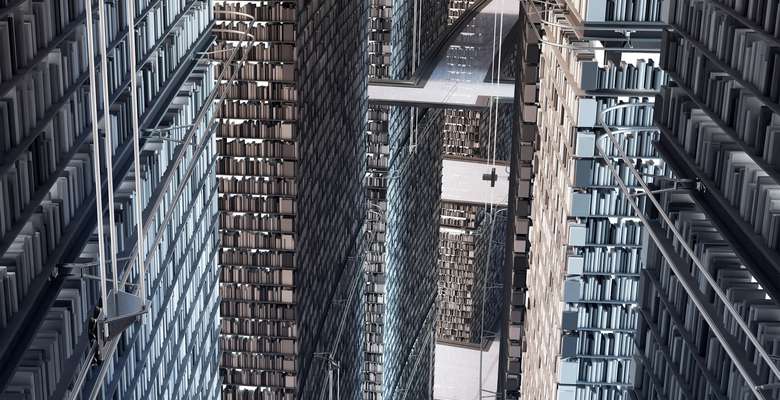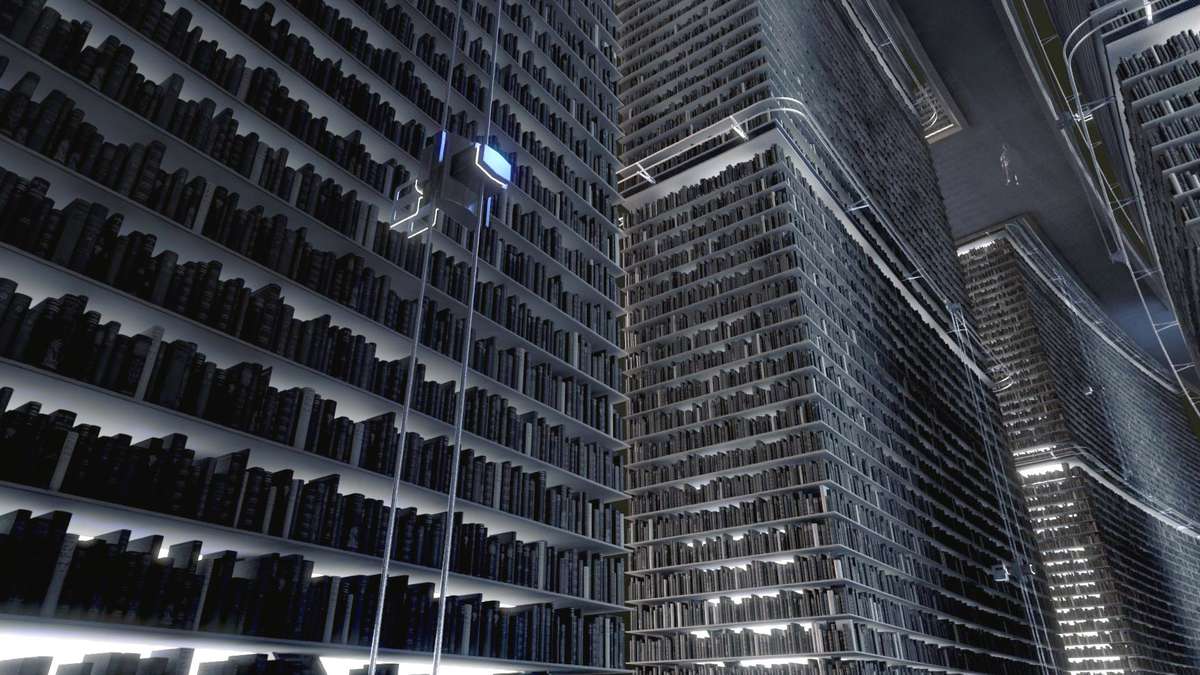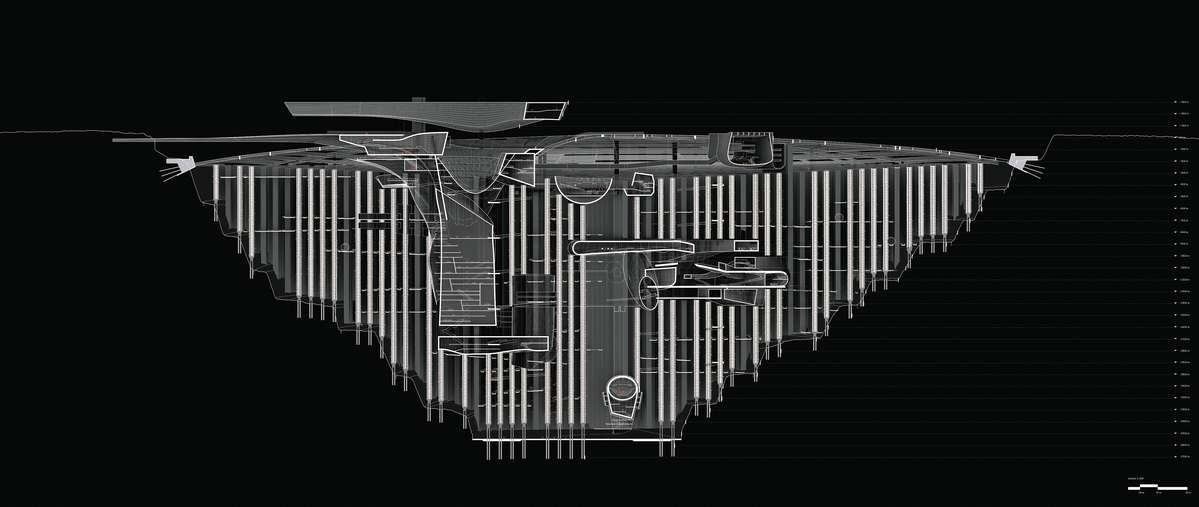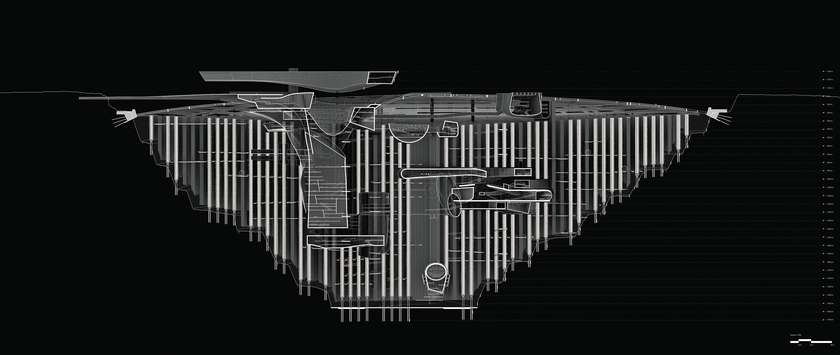Idea by
Klemens Sitzmann
Call for ideas 2019
Logium
Logium

- New alliances
Logium investigates the most revolutionary invention of humankind, the written language. The transcription of thoughts was the first medium able to overcome the natural generational boundary and pass on knowledge to future generations. Logium is in the sense of the ancient library of Alexandria an absolute library, an archive which concentrates a copy of every book ever written in one place. Far away in the Canadian Arctic, in a disused diamond mine, the Logium collects the knowledge of the world. An architecture created to endure time allows the visitor who takes the journey to immerse himself in the written consciousness of humanity. Independent of wars, political systems, economic crises and time, the Logium protects people’s knowledge, ultimately also from themselves.

The project is located in the Diavik Diamond mine in the northern territories of Canada. The open pit mine is an island in the lake Lac the Gras, situated above the polar cycle. This territory markes a unique place, an almost autonomous entity on planet earth. The terraforming intervention caused by the mining shaped two giant pits to withdraw diamonds out of the earth. When the mine will be depleted in the near future, the larger 720m diameter pit will serve as the archive space for the Logium

The archive rests in the main pit under a cupola of glass. The only programmatic point outside the archive is the accommodation for the librarians, scientists and visitors located above the main entry to the archive. The radial organization of the bookstacks mimics the tectonics of the man made surrounding. In its own way, the radial array looks and feels like a fingerprint of humankind.

The archive space consists of bookstacks grounded in the bottom of the pit and reaching to the top of the surface. Together they form a structural frame where multiple functions are embedded. All bookstacks are organized by robots. 129.864.880 unique books exist in the world according to Google. Altogether the Logium holds space for 195 millions books. Should the space run out in the future, the library will extend to the neighbouring pit.

The pit is 720m in width and 260m deep. The books are vertically layered by their release date, the most old books are stored in the bottom of the pit and the newer ones are added towards the top as information was growing exponentially. Scientists are able to apply for residencies and dedicate their entire focus on their research without the distractions of life in a city. Visitors are able to wander among the archive and experience themselves in the written consciousness of humankind

Programmatic parts of the library. These architectural functions offer different degrees of immersiveness to the user. The incorporations happens in different heights in the pit, with the downwards growing tower as the main access point to the library. Reading space and Auditorium rest beneath the cupola and the bookstack, while the rest of the functions are fully submerged into the archive space.
Logium
Logium

- New alliances
Logium investigates the most revolutionary invention of humankind, the written language. The transcription of thoughts was the first medium able to overcome the natural generational boundary and pass on knowledge to future generations. Logium is in the sense of the ancient library of Alexandria an absolute library, an archive which concentrates a copy of every book ever written in one place. Far away in the Canadian Arctic, in a disused diamond mine, the Logium collects the knowledge of the world. An architecture created to endure time allows the visitor who takes the journey to immerse himself in the written consciousness of humanity. Independent of wars, political systems, economic crises and time, the Logium protects people’s knowledge, ultimately also from themselves.

The project is located in the Diavik Diamond mine in the northern territories of Canada. The open pit mine is an island in the lake Lac the Gras, situated above the polar cycle. This territory markes a unique place, an almost autonomous entity on planet earth. The terraforming intervention caused by the mining shaped two giant pits to withdraw diamonds out of the earth. When the mine will be depleted in the near future, the larger 720m diameter pit will serve as the archive space for the Logium

The archive rests in the main pit under a cupola of glass. The only programmatic point outside the archive is the accommodation for the librarians, scientists and visitors located above the main entry to the archive. The radial organization of the bookstacks mimics the tectonics of the man made surrounding. In its own way, the radial array looks and feels like a fingerprint of humankind.

The archive space consists of bookstacks grounded in the bottom of the pit and reaching to the top of the surface. Together they form a structural frame where multiple functions are embedded. All bookstacks are organized by robots. 129.864.880 unique books exist in the world according to Google. Altogether the Logium holds space for 195 millions books. Should the space run out in the future, the library will extend to the neighbouring pit.

The pit is 720m in width and 260m deep. The books are vertically layered by their release date, the most old books are stored in the bottom of the pit and the newer ones are added towards the top as information was growing exponentially. Scientists are able to apply for residencies and dedicate their entire focus on their research without the distractions of life in a city. Visitors are able to wander among the archive and experience themselves in the written consciousness of humankind

Programmatic parts of the library. These architectural functions offer different degrees of immersiveness to the user. The incorporations happens in different heights in the pit, with the downwards growing tower as the main access point to the library. Reading space and Auditorium rest beneath the cupola and the bookstack, while the rest of the functions are fully submerged into the archive space.